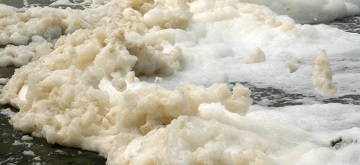400516-seafoam.jpg

Sea foam at Ocean Beach in San Francisco. Credit: National Oceanic and Atmospheric Administration
The foam on a latte, or the foamy meringue on top of a lemon pie, can be a delightful treat. The foam on the ocean? Not so much. It contains some ingredients that you don’t want to eat.
Sea foam is created by strong winds. As the wind blows across the water, it creates waves. When the waves ripple and break, they create bubbles of air. But it’s the material that forms the “skin” of the bubbles that can be so unappetizing.
In the foam on a latte, the bubbles are made of fat and protein molecules from milk. In meringue, it’s protein in the egg whites. And in sea foam, the bubbles are also made from organic materials. In many cases, it’s the algae in “red tides” or the residue of other marine life. The bubbles also can come from human sources — fertilizers that wash out to sea, or the discharge from sewage plants.
Most patches of sea foam are small and short-lived. But strong storms can generate thick layers that stick around for hours or even days. A storm in Australia in 2007, for example, produced a layer of foam that was taller than a house and stretched across miles of ocean.
Such massive foams look and feel like mounds of dirty whipped cream. They’re generally not dangerous to people, although the foam created by some organisms can cause itchy eyes and minor breathing problems. And foams have been blamed for a few seabird die-offs. The bubbles stripped away the waterproof material on the birds’ feathers, allowing cold water to hit their skin — causing the birds to freeze to death.

